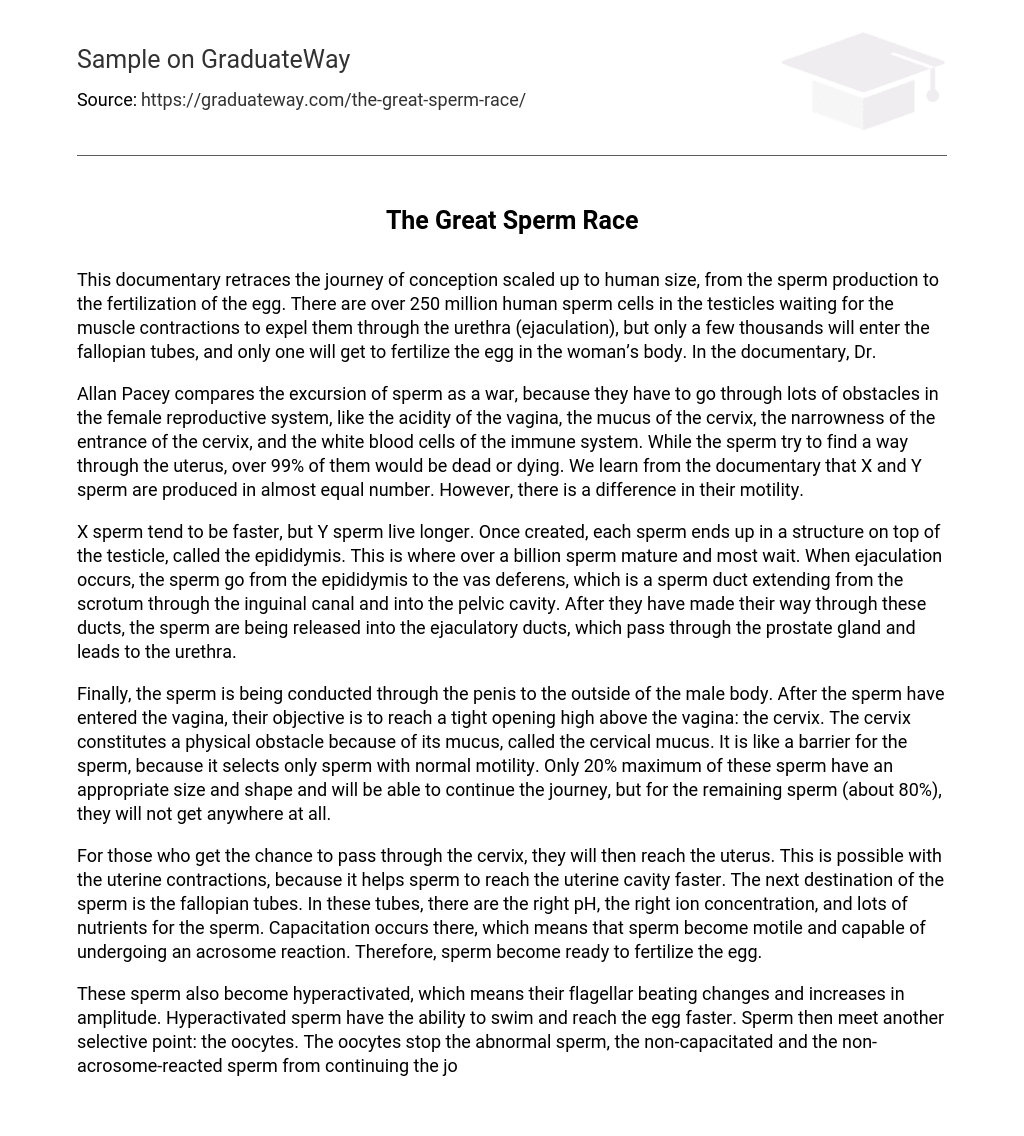This documentary retraces the journey of conception scaled up to human size, from the sperm production to the fertilization of the egg. There are over 250 million human sperm cells in the testicles waiting for the muscle contractions to expel them through the urethra (ejaculation), but only a few thousands will enter the fallopian tubes, and only one will get to fertilize the egg in the woman’s body. In the documentary, Dr.
Allan Pacey compares the excursion of sperm as a war, because they have to go through lots of obstacles in the female reproductive system, like the acidity of the vagina, the mucus of the cervix, the narrowness of the entrance of the cervix, and the white blood cells of the immune system. While the sperm try to find a way through the uterus, over 99% of them would be dead or dying. We learn from the documentary that X and Y sperm are produced in almost equal number. However, there is a difference in their motility.
X sperm tend to be faster, but Y sperm live longer. Once created, each sperm ends up in a structure on top of the testicle, called the epididymis. This is where over a billion sperm mature and most wait. When ejaculation occurs, the sperm go from the epididymis to the vas deferens, which is a sperm duct extending from the scrotum through the inguinal canal and into the pelvic cavity. After they have made their way through these ducts, the sperm are being released into the ejaculatory ducts, which pass through the prostate gland and leads to the urethra.
Finally, the sperm is being conducted through the penis to the outside of the male body. After the sperm have entered the vagina, their objective is to reach a tight opening high above the vagina: the cervix. The cervix constitutes a physical obstacle because of its mucus, called the cervical mucus. It is like a barrier for the sperm, because it selects only sperm with normal motility. Only 20% maximum of these sperm have an appropriate size and shape and will be able to continue the journey, but for the remaining sperm (about 80%), they will not get anywhere at all.
For those who get the chance to pass through the cervix, they will then reach the uterus. This is possible with the uterine contractions, because it helps sperm to reach the uterine cavity faster. The next destination of the sperm is the fallopian tubes. In these tubes, there are the right pH, the right ion concentration, and lots of nutrients for the sperm. Capacitation occurs there, which means that sperm become motile and capable of undergoing an acrosome reaction. Therefore, sperm become ready to fertilize the egg.
These sperm also become hyperactivated, which means their flagellar beating changes and increases in amplitude. Hyperactivated sperm have the ability to swim and reach the egg faster. Sperm then meet another selective point: the oocytes. The oocytes stop the abnormal sperm, the non-capacitated and the non-acrosome-reacted sperm from continuing the journey towards the egg. The mammalian egg is enclosed by the zona pellicula, which is composed of granulosa cells and facilitates the fertilization.
Sperm that have successfully made it through all the obstacles will be able to enter in contact with the zona around the egg, but only one will get to penetrate into the egg and fertilizes it. Fertilization occurs when the head of the sperm bursts to let its inside full of enzymes fuse with the plasma membrane of the egg. In contrast of the billions of sperm produced continuously in a man’s body, a woman would produce just one egg per month. One egg has a limited lifetime and only lasts for 24 hours.
This is why timing is so important for the sperm, as arriving at the egg too late or too early would lead them to death. After the sperm has fertilized the egg, the male chromosomes are going to melt with the female chromosomes. It is the sign that the creation of a new individual is about to start. I think this documentary is very interesting in the way that it helps to comprehend how fertilization occurs. With the human scale that the producers have used, it is easy to understand all the processes from the sexual reproduction to the birth of the embryo.





